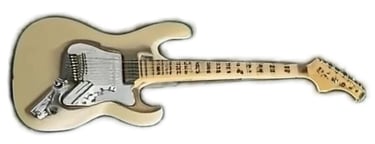
Build Skills Fast: Essential Guitar Drills for Beginners
Master the basics with effective guitar drills for beginners. Strengthen your fingers, improve coordination, and build confidence with simple daily exercises!
magicchords.com
8/5/2025


Want to improve your playing quickly? These essential Guitar Drills for Beginners focus on accuracy, finger strength, and rhythm to build strong foundational skills from day one.
Starting your guitar journey is exciting, but it can also feel overwhelming without a clear practice plan. That’s where Guitar Drills for Beginners come in. Designed to build strength, coordination, and confidence, these simple yet effective exercises are essential for developing strong foundational skills. Whether you're picking up the guitar for the first time or returning after a break, structured guitar drills for beginners will help you progress faster and play cleaner.
Practicing scales, finger placement, chord transitions, and rhythm patterns regularly can make a noticeable difference in your playing. These guitar drills not only improve your technical ability but also train your ear and build muscle memory, making it easier to learn songs and improvise with confidence. As a beginner, focusing on accuracy and consistency is more important than speed. With time and repetition, your fingers will move more fluidly across the fretboard, and your strumming will become more natural.


In this blog post, we’ll explore easy and practical guitar drills for beginners that you can practice daily, even if you only have ten minutes. From warm-ups to chord switching and simple picking exercises, each drill is designed to target a specific skill. By including these in your regular practice routine, you’ll lay the groundwork for future success and develop the confidence to tackle more advanced techniques. Let’s dive in and start building your skills with focused, beginner-friendly guitar drills.


Tip 1: Learning to play guitar involves more than just memorizing chords and songs. Developing solid technique through guitar drills for beginners helps build finger strength, accuracy, and confidence. Equally important is instrument maintenance, and that includes changing acoustic guitar strings regularly to keep your sound clean and bright. By combining structured practice with proper care, beginners can progress faster and enjoy a more rewarding and consistent playing experience from the very beginning.


Introduction to Guitar Drills
For beginners embarking on their guitar-playing journey, engaging in guitar drills is an essential aspect of developing fundamental skills. These drills serve as dedicated practice exercises designed to enhance various techniques crucial for proficient playing. Regular practice through structured drills can significantly increase accuracy, finger strength, and rhythm, laying a solid foundation for advancing on the instrument.
One of the primary benefits of guitar drills is their ability to improve accuracy. By focusing on specific patterns or techniques repetitively, beginners can train their fingers to hit the correct notes more consistently. This precision is vital when transitioning from simple chords to more complex melodies, ensuring that each note sounds clear and articulate.
In addition to accuracy, guitar drills also play a critical role in building finger strength. Novice players often struggle with the physical demands of playing the guitar, particularly in the early stages. Targeted drills can help develop the necessary dexterity and strength in the fingers, allowing for smoother transitions between chords and more controlled playing overall. Over time, this strength leads to greater endurance during extended practice sessions or performances.
Rhythm and timing are equally essential elements of guitar playing that can be honed through consistent drill practice. By incorporating exercises that emphasize strumming patterns or fingerpicking techniques, beginners can cultivate a strong sense of rhythm. This aspect not only aids in playing with accuracy but also improves the overall musicality of a performance, helping players to keep time while playing along with other musicians.
Beginners must recognize the importance of incorporating guitar drills into their practice routines. Through consistent engagement with these exercises, players can significantly improve their accuracy, finger strength, and rhythm, all of which are fundamental to successful guitar playing. As players progress, the skills acquired through these drills will serve as a foundation for more advanced techniques and musical expression.
Benefits of Guitar Drills for Beginners
For aspiring musicians, especially beginners, engaging in targeted guitar drills presents a plethora of advantages that significantly enhance their learning experience. One primary benefit is the development of muscle memory. Through consistent practice, guitar drills enable beginners to perform finger placements accurately and instinctively. This fundamental skill is crucial as it allows them to navigate the fretboard with ease, ultimately leading to fluid and confident playing.
In addition to muscle memory, guitar drills also promote finger independence. Many novices struggle with coordination between their left and right hands, which can impede their progress. By incorporating specific drills aimed at enhancing dexterity, learners can refine their finger movements. This improvement fosters greater control over chords and scales, enabling them to execute more complex pieces over time.
Another critical area where guitar drills provide immense value is in improving timing and rhythm. Many beginners find that understanding these musical elements can be challenging. Regular practice with metronomes and rhythm drills encourages students to develop a keen sense of timing, allowing them to play more cohesively with other musicians or along with backing tracks. Such a skill is vital in creating a well-rounded musical product.
Moreover, the psychological impact of mastering guitar drills cannot be overlooked. As beginners progress through their practice routines, they experience tangible improvement, which in turn boosts their overall confidence. This enhancement not only motivates them to continue practicing but also cultivates a positive mindset toward their musical journey. Ultimately, as beginners observe their own advancements, the obstacles they face become less daunting, encouraging sustained engagement with their instrument.
Guitar Drills for Beginners #1: Finger Exercises
One of the foundational skills necessary for any aspiring guitarist is finger independence. Developing this skill is crucial as it enhances dexterity, enabling players to tackle more complex songs and techniques with ease. Finger independence exercises primarily focus on reinforcing the ability to move each finger independently of the others, which is vital when playing chords or scales.
A highly effective exercise is the "1-2-3-4" drill. For this exercise, place your fingers on the fretboard: index (1), middle (2), ring (3), and pinky (4). Starting at the low E string, play the first fret with your index finger, then move to the second fret with your middle finger, the third fret with your ring finger, and the fourth fret with your pinky. Repeat this on each string, descending from the sixth string to the first, and focus on maintaining a steady rhythm. Practicing this drill not only builds finger strength but also improves coordination between your left-hand fingers.
Another beneficial exercise is the "Fretted Notes Combination." For this drill, choose a string and play different frets in a non-sequential order, such as 1st, 3rd, 2nd, and 4th. This method challenges your brain to think about finger movements rather than relying on muscle memory. Focus on clean transitions and note clarity, ensuring that your fingers are lifting away from the strings sufficiently to avoid muting adjacent notes.
Incorporating finger independence exercises into your daily practice is essential for any beginner guitarist. As these drills enhance dexterity and facilitate better control, they lay the groundwork for more advanced techniques. Over time, consistent practice will enable players to explore complex musical arrangements with greater confidence and agility, ultimately enriching their overall guitar-playing experience.
Guitar Drills for Beginners #2: Scales
Practicing scales and chromatic runs is fundamental for beginners seeking to develop their guitar skills efficiently. These essential drills not only enhance finger dexterity but also lay the groundwork for a comprehensive understanding of music theory and note relationships. Engaging in regular scale practice improves pitch recognition and facilitates a smoother transition between notes during play.
To begin with major scales, start by positioning your fingers on the frets according to the following pattern: on the 6th string (E), play the open string followed by the 2nd fret (F#), 4th fret (G#), 5th fret (A), 7th fret (B), 9th fret (C#), and 11th fret (D#), concluding with the 12th fret (E). It is beneficial to repeat this process on each of the six strings, ascending and descending, as it builds muscle memory and a deeper familiarity with the guitar's fretboard.
Next, for minor scales, follow a similar method. For the A minor scale, begin on the 5th fret of the 6th string (E string). Play the following notes: A (5th fret), B (7th fret), C (8th fret), D (10th fret), E (12th fret), F (13th fret), G (15th fret), and return back to A. Practicing these drills with a metronome helps in maintaining rhythm and timing, ensuring a solid foundation for your musical endeavors.
Chromatic runs involve playing every note in succession on the fretboard, allowing for seamless navigation between notes without skipping any. Start on any fret and play each consecutive fret up to the twelfth fret before descending back down. This drill reinforces finger independence while developing a quicker response time when playing complex pieces.
By integrating scales and chromatic exercises into your daily practice routine, you can significantly expand your musical knowledge, improve overall performance, and cultivate the skills necessary for more advanced playing techniques in the future.
Guitar Drills for Beginners #3: Chord Transitions
One of the fundamental skills that a beginner guitarist must develop is the ability to switch between chords seamlessly. Chord transitions are crucial for maintaining the flow of music and ensuring that songs are played smoothly and rhythmically. This drill focuses specifically on improving your ability to transition between common chords, aiding in both accuracy and speed. To make your practice sessions more effective, it is essential to focus on specific chords that are frequently used together in songs, such as G, C, D, and Em.
Start by practicing each chord individually until you are comfortable forming them. Once you have grasped the shapes, begin to practice switching between them. A common approach is to set a metronome at a slow tempo. This will allow you to play each chord with steady timing. Begin with a simple two-chord transition, for example, switching back and forth between G and C. Repeat this process several times, gradually increasing the speed of the metronome as you develop confidence.
Another effective strategy for practicing chord transitions is to use a visual or mental cue related to the music you are learning. Associating specific transitions with a melody can help to embed these movements into your muscle memory. Additionally, try to focus on the fluidity of your hand movements; paying special attention to how your fingers move from one position to another. Practicing slowly and accurately is preferable to playing quickly and sloppily, as it fosters better habits in the long term.
As you become more comfortable with common chord transitions, you may wish to challenge yourself by incorporating different progressions and varying tempos. Regular practice of these drills will greatly enhance your overall guitar playing skills, leading to more enjoyable and confident performances.
Guitar Drills: Rhythm and Strumming Patterns
Developing a solid foundation in rhythm and strumming patterns is essential for any beginner guitarist. These elements are critical for effective musical expression and cohesiveness in performance. A guitarist's ability to maintain an even tempo can greatly influence the overall quality of their sound. To enhance these skills, several targeted drills are recommended.
One effective exercise is the practice of simple downstrokes. Begin by striking the strings evenly with a consistent motion, keeping your hand relaxed and your movements fluid. Start at a slow tempo, focusing on accuracy and consistency of each stroke. Using a metronome can be beneficial in maintaining the desired speed, gradually increasing the tempo as proficiency improves. This practice not only hones strumming technique but also reinforces internal rhythmic timing.
Once comfortable with downstrokes, introducing upstrokes adds complexity to the rhythm practice. Alternate between down and up strokes while keeping a steady beat. It helps establish coordination between your strumming hand and your fretting hand, which is crucial for progressing to more complex patterns later on. Beginners can also integrate additional accents to their strumming patterns by emphasizing certain strokes, which adds dynamics to their playing.
Another important aspect to consider is incorporating different strumming patterns into familiar songs. By selecting accessible tracks, you can practice applying various rhythms in context. Try to mimic original recordings by listening closely to the nuances of strumming; this practice will enhance your rhythmic precision and adaptability.
Consistent practice of these rhythm drills will lead to improved timing, coordination, and overall guitar performance. As you continue developing these essential skills, your confidence in playing a variety of rhythms will grow, ultimately leading to a richer and more engaging musical experience.
Crafting a Structured Practice Routine
Establishing a practice routine is crucial for any beginner guitarist seeking to effectively incorporate essential drills into their daily schedule. A well-structured routine not only promotes skill development but also helps in tracking progress over time. Here are key steps to design a practice routine tailored to beginners.
First, allocate specific time slots for practice. Aim for a minimum of 30 minutes per day, which can be expanded as your skills improve. Divide this time among various drills, dedicating around 10 minutes for each. For instance, start with warm-up exercises, then move to finger exercises, chord practice, and finally finish with scales. By segmenting your practice, you can maintain focus on each drill without becoming overwhelmed.
Next, it’s essential to incorporate a progress tracking system. Consider using a practice journal or an app to record time spent on each exercise, note improvements, and jot down any challenges faced. This documentation provides valuable insight into your learning process and helps identify areas that may need more attention.
Maintaining motivation is another critical component of a successful practice routine. Set small, achievable goals that can be accomplished within short time frames. For example, mastering a particular chord change or completing a scale exercise without mistakes. Celebrate these milestones, as they serve as motivational boosts to keep you engaged in your practice.
Finally, make sure to periodically reassess your practice routine. As you progress, modify the drill durations and focus areas to keep the practice engaging and aligned with your growth. By implementing these strategies, beginners will find it easier to integrate essential guitar drills naturally into their daily practice, leading to effective and enjoyable learning experiences.
Starting with basic techniques is key to steady progress on the guitar. Practicing guitar drills for beginners helps develop finger strength and accuracy, especially when learning essential chords like the A minor chord. Focusing on clean transitions and consistent strumming builds a strong foundation, making it easier to learn songs and gain confidence as you advance in your playing journey.




